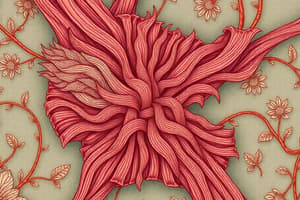Podcast
Questions and Answers
Which type of muscle tissue is striated and voluntary?
Which type of muscle tissue is striated and voluntary?
- Smooth muscle
- Cardiac muscle
- Skeletal muscle (correct)
- All of the above
Match the following muscle types to their characteristics:
Match the following muscle types to their characteristics:
Skeletal Muscle = Voluntary, Striated Cardiac Muscle = Involuntary, Striated Smooth Muscle = Involuntary, Non-striated
What are the three types of muscle tissue?
What are the three types of muscle tissue?
Skeletal, Cardiac, Smooth
The __________ is the functional unit of a muscle.
The __________ is the functional unit of a muscle.
Smooth muscle is under voluntary control.
Smooth muscle is under voluntary control.
What is the role of calcium in muscle contraction?
What is the role of calcium in muscle contraction?
Which of the following correctly describes isotonic contractions?
Which of the following correctly describes isotonic contractions?
The nervous system is responsible for taking in information and sending out a response.
The nervous system is responsible for taking in information and sending out a response.
The protective layers of the brain are called __________.
The protective layers of the brain are called __________.
Which neuroglial cell creates the blood-brain barrier?
Which neuroglial cell creates the blood-brain barrier?
What ions are primarily involved in the generation of action potentials?
What ions are primarily involved in the generation of action potentials?
Flashcards are hidden until you start studying
Study Notes
Muscle Tissue Types and Functions
- Skeletal Muscle: Long, cylindrical, striated, multinucleated, attached to bones; responsible for voluntary movement.
- Cardiac Muscle: Short, branched, striated, uninucleated, located in the heart; involuntary contraction aided by intercalated discs.
- Smooth Muscle: Spindle-shaped, uninucleated, non-striated, found in hollow organs; involuntary control.
- Muscle functions include excitability, conductivity, extensibility, elasticity, and contractility.
Anatomy of Skeletal Muscle
- Sarcomere: The basic contractile unit, featuring z-disc, m-line, a band, I band, and zones of overlap.
- Proteins in Muscle: Comprise contractile (actin and myosin), structural, and regulatory types.
- Connective Tissue: Includes epimysium (surrounding entire muscle), perimysium (surrounding fascicles), and endomysium (surrounding individual muscle fibers).
Muscle Contraction Physiology
- Sliding Filament Theory: Actin and myosin filaments slide past one another to enable contraction.
- Important Structures:
- Actin and myosin facilitate muscle contractions.
- Calcium ions bind to troponin, moving tropomyosin and exposing active sites on actin.
- ATP Role: Binds to myosin, releasing energy via hydrolysis to ADP and phosphate; necessary for actin-myosin engagement.
Neural Control of Muscle Movement
- Action Potential Phases:
- Polarization: No ionic exchange, muscle at rest.
- Depolarization: Sodium influx, muscle contracts.
- Repolarization: Potassium efflux, muscle relaxes.
- Neuromuscular Junction: Calcium release leads to acetylcholine (ACh) release into the synaptic cleft, initiating muscle contraction.
Energy Metabolism in Muscles
- Aerobic vs. Anaerobic: Skeletal muscles switch from aerobic respiration to anaerobic glycolysis during intense exercise due to reduced oxygen delivery.
- Creatine Kinase: A high-energy phosphate system that replenishes ATP quickly.
Types of Muscle Contractions
- Isometric Contraction: Muscle tension increases without changing length; occurs against a load greater than muscle tension.
- Isotonic Contraction: Muscle changes length while exerting force; can be concentric (shortening) or eccentric (lengthening).
Major Skeletal Muscles Identification
- Muscle Nomenclature: Based on direction, size, shape, action, number of origins, location, and origin/insertion sites.
- Common muscle actions include:
- Flexor: Decreases joint angle.
- Extensor: Increases joint angle.
- Abductor: Moves bone away from midline.
- Adductor: Moves bone closer to midline.
Nervous System Organization and Function
- Functional Organization:
- Sensory (afferent): Carries sensory input to the CNS.
- Interneurons (integration): Process information.
- Motor (efferent): Sends commands from CNS to muscles or glands.
Anatomy of the Nervous System
- CNS: Comprises the brain and spinal cord.
- PNS: Includes somatic (voluntary) and autonomic (involuntary) systems.
Protective Structures of the Nervous System
- Cranial Bones & Vertebral Column: Structural protection.
- Meninges: Three protective layers: dura mater, arachnoid mater, pia mater.
- Cerebrospinal Fluid (CSF): Provides cushioning and nutrient transport.
Neuron Structure and Function
- Neuron Components: Includes dendrites, soma, axon hillock, axon, myelin sheath, and synaptic bulbs, each serving a specific function.
- Neuroglia Functions: Support and protect neurons; include astrocytes, oligodendrocytes, microglial cells, and ependymal cells in the CNS, and Schwann and satellite cells in the PNS.
Neurophysiology and Action Potentials
- Conduction: Faster in myelinated axons due to saltatory conduction at nodes of Ranvier.
- Graded vs. Action Potentials:
- Graded potentials are local changes in membrane potential and vary in strength.
- Action potentials are full-scale depolarizations that do not lose strength over distance and propagate along axons.
Synaptic Function
- Various synapse types, including axodendritic, axosomatic, and axoaxonic, mediate communication between neurons.
- 1st Messengers: Neurotransmitters or hormones that initiate cellular responses through specific receptors.
Muscle Movement Terminology
- Antagonist Muscles: Oppose action of prime movers.
- Agonist Muscles: Primary movers of an action.
- Synergist Muscles: Assist prime movers in actions.
- Fixator Muscles: Stabilize the origin of the prime mover.
Studying That Suits You
Use AI to generate personalized quizzes and flashcards to suit your learning preferences.




